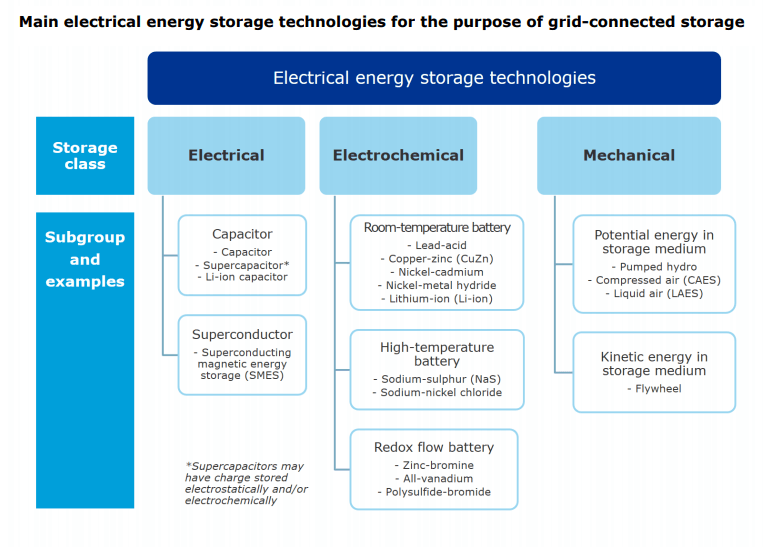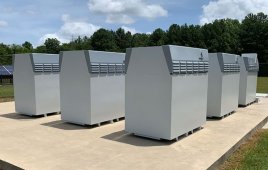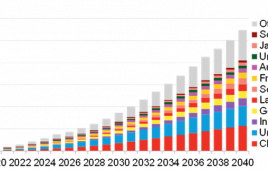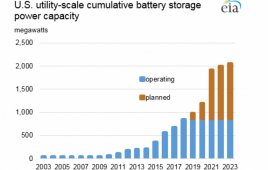DNV GL, the world’s largest resource of independent energy experts and certification body, today published an update of its GRIDSTOR Recommended Practice (DNVGL-RP-0043) for grid-connected energy storage. The updated version incorporates the latest storage technologies and market developments and provides the most up to date recommendations on safety, operation, and performance for grid-connected energy storage systems.
GRIDSTOR is an independent set of recommendations combining all key standards and guidelines with credible industry experience and insights, to help guarantee the safe implementation and operation of energy storage systems for all stakeholders such as end users, manufacturers, investors or insurance companies. It has been updated by an international consortium including experts from 15 global organizations.

The storage class “Electrical”, referring to the form of energy inside the storage medium, should not be
confused with the higher-level categorization “Electrical energy storage”, referring to the form of energy
going into and out of the system.
As the energy storage sector undergoes rapid developments and innovations, the Recommended Practice requires regular updates. Currently over 200 other guidance documents are available that can be applied to grid-scale energy storage systems or components. As the grid-scale energy storage market is rapidly growing, it relies on independent risk mitigation, to ensure growth happens with the required quality and safety standards, further enabling the energy transition.
Energy storage is a key measure to provide flexibility, as increasing renewable generation is needed to allow electricity systems to continue to operate stably and economically. DNV GL’s recently published Energy Transition Outlook report forecasts, that renewable sources will account for 85% of the world’s electricity production. Additional ‘flexibility’ functions such as storage technology are needed to allow electricity systems to continue to operate stably and economically.
The updated Recommended Practice has been developed by an international consortium including experts from 15 global organisations: Alaska Center for Energy and Power, Alfen, Alevo, ATEPS, Conergy, Datawatt, DNV GL, Enexis, Gaelectric, Highview Power, Hybrid Europe, Maxwell, PNNL (in support of the U.S. Department Of Energy Office of Electricity energy storage safety strategy), RWTH and Wärtsilä.
Following the consortium approval, the document has been further improved and validated by the international energy storage community through a public hearing process, involving more than 140 global organizations.
The global scope as well as input from universal stakeholders such as manufacturers, system integrators, utilities, project developers, universities, government bodies, and others, ensure industry-wide acceptance and alignment of the Recommended Practice.
The updated GRIDSTOR recommended practice provides the latest industry guidelines on:
- Cybersecurity
- Communication protocols
- Microgrids
- Conformity assessment incl. FAT/SAT testing
- Warranty
- Decommissioning
- Tendering and procurement
- Bankability
- Residual value
- Greenhouse gas emissions calculation
References to standards and guidelines were updated and various recommendations were adjusted to match, including for example the well-known recent IEC 62933 standard, published by IEC’s TC-120.
“Energy storage is playing an increasingly important role in providing a reliable and secure power supply. Whether this is with regards to the integration of renewables into the energy mix, ancillary services, bulk energy services or any other form of the wide variety of applications. GRIDSTOR provides the most relevant Recommended Practice allowing all stakeholders to safely develop the vital technological and system advancements using energy storage,” said Ditlev Engel, CEO at DNV GL – Energy.
Two members of the consortium of the consortium commented on the updated GRIDSTOR Recommended Practice:
“This new and updated global standard on advanced utility and microgrid energy storage explains how storage performs as a Swiss army knife delivering multiple streams of value to utilities, ratepayers, and their regulators,” said David Lentsch, Senior Manager Energy Storage at Maxwell Technologies
“As a developer and EPC provider, we are strongly convinced that using the GRIDSTOR Recommended Practice will increase the comfort and hence the ability of lenders and investors to engage in financing of the vast business opportunities in the field of storage and hence allowing everyone to benefit from this technology. We can already see the benefit of GRIDSTOR and its immediate positive impact in the Asia – Pacific region today,” commented Hendrik R. Bohne, Vice President EPC Asia & Pacific at Conergy Asia & ME.
The updated DNV GL Recommended Practice on grid-connected energy storage systems is available to download here.
Filed Under: Energy storage




